Nicholas P. Cheremisinoff. Handbook of Solid Waste Management and Waste Minimization Technologies
Подождите немного. Документ загружается.

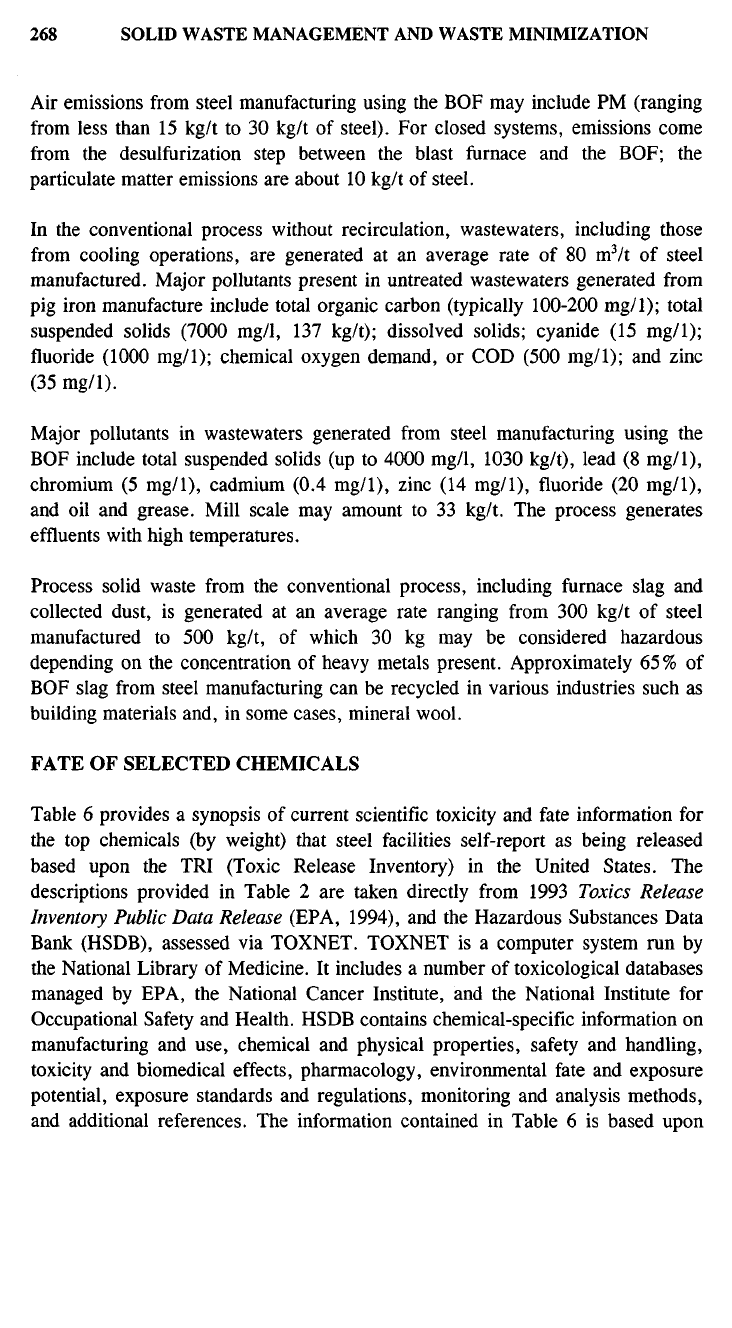
Air emissions from steel manufacturing using the BOF may include PM (ranging
from less than 15 kg/t to 30 kg/t of steel). For closed systems, emissions come
from the desulfurization step between the blast furnace and the BOF; the
particulate matter emissions are about 10 kg/t of steel.
In the conventional process without recirculation, waste
waters,
including those
from cooling operations, are generated at an average rate of 80 mVt of steel
manufactured. Major pollutants present in untreated wastewaters generated from
pig iron manufacture include total organic carbon (typically 100-200 mg/1); total
suspended solids (7000 mg/1, 137 kg/t); dissolved solids; cyanide (15 mg/1);
fluoride (1000 mg/1); chemical oxygen demand, or COD (500 mg/1); and zinc
(35 mg/1).
Major pollutants in wastewaters generated from steel manufacturing using the
BOF include total suspended solids (up to 4000 mg/1, 1030 kg/t), lead (8 mg/1),
chromium (5 mg/1), cadmium (0.4 mg/1), zinc (14 mg/1), fluoride (20 mg/1),
and oil and grease. Mill scale may amount to 33 kg/t. The process generates
effluents with high temperatures.
Process solid waste from the conventional process, including furnace slag and
collected dust, is generated at an average rate ranging from 300 kg/t of steel
manufactured to 500 kg/t, of which 30 kg may be considered hazardous
depending on the concentration of heavy metals present. Approximately 65% of
BOF slag from steel manufacturing can be recycled in various industries such as
building materials and, in some cases, mineral wool.
FATE OF SELECTED CHEMICALS
Table 6 provides a synopsis of current scientific toxicity and fate information for
the top chemicals (by weight) that steel facilities self-report as being released
based upon the TRI (Toxic Release Inventory) in the United States. The
descriptions provided in Table 2 are taken directly from 1993 Toxics Release
Inventory Public Data Release (EPA, 1994), and the Hazardous Substances Data
Bank (HSDB), assessed via TOXNET. TOXNET is a computer system run by
the National Library of Medicine. It includes a number of toxicological databases
managed by EPA, the National Cancer Institute, and the National Institute for
Occupational Safety and Health. HSDB contains chemical-specific information on
manufacturing and use, chemical and physical properties, safety and handling,
toxicity and biomedical effects, pharmacology, environmental fate and exposure
potential, exposure standards and regulations, monitoring and analysis methods,
and additional references. The information contained in Table 6 is based upon
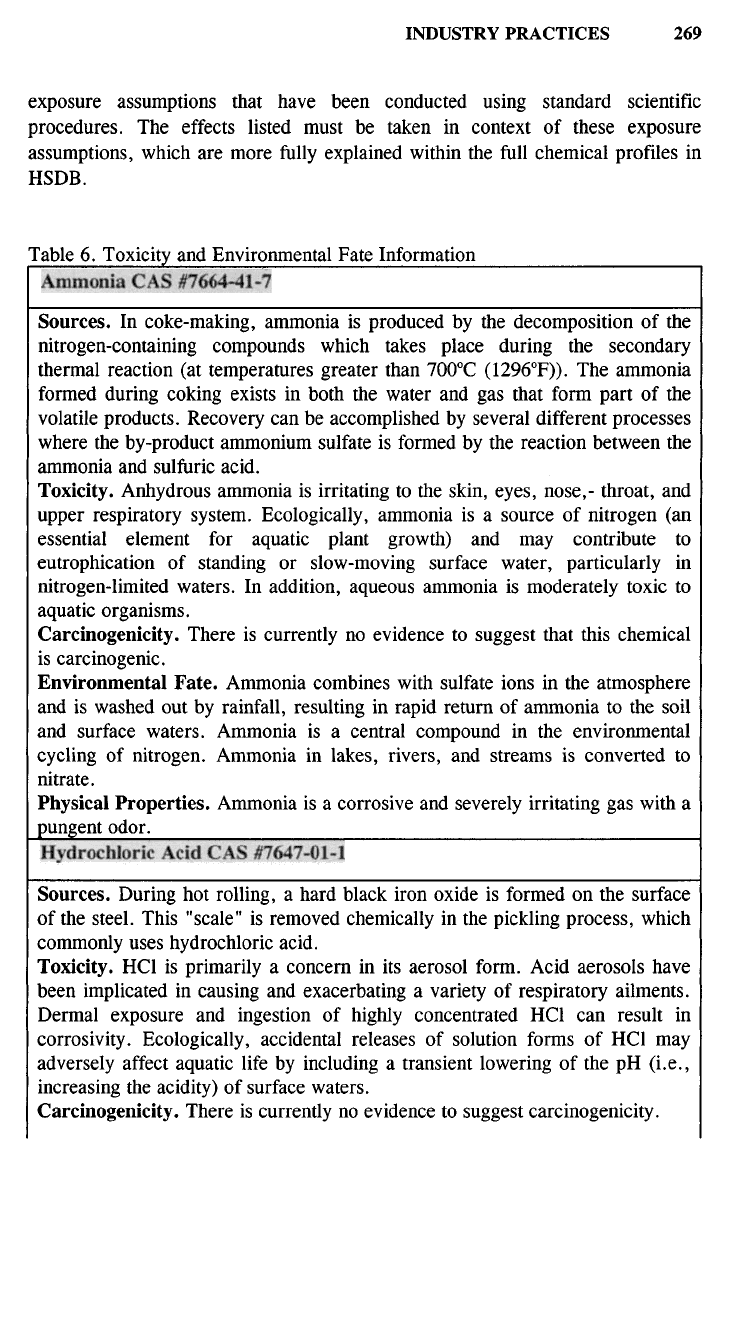
Table 6. Toxicity and Environmental Fate Information
Ammonia CAS #7664-41-7
Sources. In coke-making, ammonia is produced by the decomposition of the
nitrogen-containing compounds which takes place during the secondary
thermal reaction (at temperatures greater than 700
0
C (1296
0
F)). The ammonia
formed during coking exists in both the water and gas that form part of the
volatile products. Recovery can be accomplished by several different processes
where the by-product ammonium sulfate is formed by the reaction between the
ammonia and sulfuric acid.
Toxicity. Anhydrous ammonia is irritating to the skin, eyes, nose,- throat, and
upper respiratory system. Ecologically, ammonia is a source of nitrogen (an
essential element for aquatic plant growth) and may contribute to
eutrophication of standing or slow-moving surface water, particularly in
nitrogen-limited waters. In addition, aqueous ammonia is moderately toxic to
aquatic organisms.
Carcinogenicity. There is currently no evidence to suggest that this chemical
is carcinogenic.
Environmental Fate. Ammonia combines with sulfate ions in the atmosphere
and is washed out by rainfall, resulting in rapid return of ammonia to the soil
and surface waters. Ammonia is a central compound in the environmental
cycling of nitrogen. Ammonia in lakes, rivers, and streams is converted to
nitrate.
Physical Properties. Ammonia is a corrosive and severely irritating gas with a
pungent odor.
Hydrochloric Acid CAS #7647-01-1
Sources. During hot rolling, a hard black iron oxide is formed on the surface
of the steel. This "scale" is removed chemically in the pickling process, which
commonly uses hydrochloric acid.
Toxicity. HCl is primarily a concern in its aerosol form. Acid aerosols have
been implicated in causing and exacerbating a variety of respiratory ailments.
Dermal exposure and ingestion of highly concentrated HCl can result in
corrosivity. Ecologically, accidental releases of solution forms of HCl may
adversely affect aquatic life by including a transient lowering of the pH (i.e.,
increasing the acidity) of surface waters.
Carcinogenicity. There is currently no evidence to suggest carcinogenicity.
exposure assumptions that have been conducted using standard scientific
procedures. The effects listed must be taken in context of these exposure
assumptions, which are more fully explained within the full chemical profiles in
HSDB.
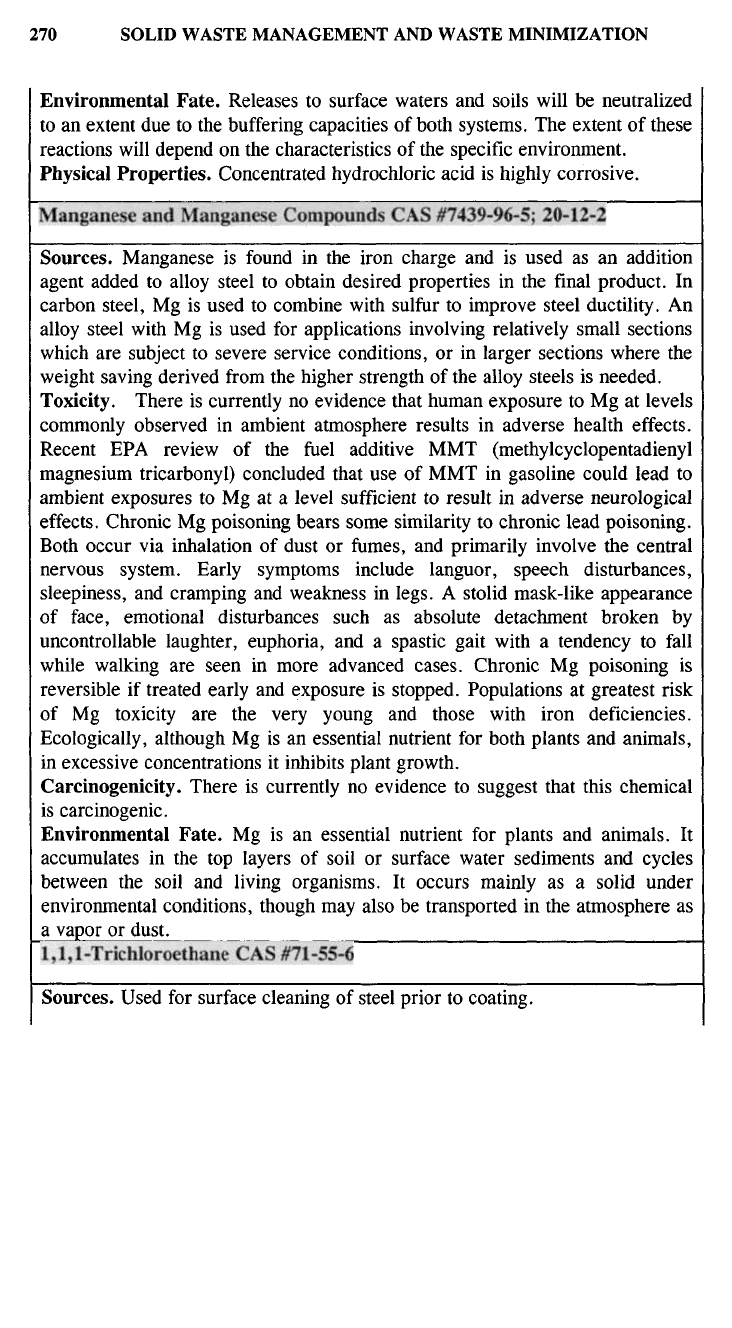
Environmental Fate. Releases to surface waters and soils will be neutralized
to an extent due to the buffering capacities of both systems. The extent of these
reactions will depend on the characteristics of the specific environment.
Physical Properties. Concentrated hydrochloric acid is highly corrosive.
Manganese and Manganese Compounds CAS #7439-96-5; 20-12-2
Sources. Manganese is found in the iron charge and is used as an addition
agent added to alloy steel to obtain desired properties in the final product. In
carbon steel, Mg is used to combine with sulfur to improve steel ductility. An
alloy steel with Mg is used for applications involving relatively small sections
which are subject to severe service conditions, or in larger sections where the
weight saving derived from the higher strength of the alloy steels is needed.
Toxicity. There is currently no evidence that human exposure to Mg at levels
commonly observed in ambient atmosphere results in adverse health effects.
Recent EPA review of the fuel additive MMT (methylcyclopentadienyl
magnesium tricarbonyl) concluded that use of MMT in gasoline could lead to
ambient exposures to Mg at a level sufficient to result in adverse neurological
effects. Chronic Mg poisoning bears some similarity to chronic lead poisoning.
Both occur via inhalation of dust or fumes, and primarily involve the central
nervous system. Early symptoms include languor, speech disturbances,
sleepiness, and cramping and weakness in legs. A stolid mask-like appearance
of face, emotional disturbances such as absolute detachment broken by
uncontrollable laughter, euphoria, and a spastic gait with a tendency to fall
while walking are seen in more advanced cases. Chronic Mg poisoning is
reversible if treated early and exposure is stopped. Populations at greatest risk
of Mg toxicity are the very young and those with iron deficiencies.
Ecologically, although Mg is an essential nutrient for both plants and animals,
in excessive concentrations it inhibits plant growth.
Carcinogenicity. There is currently no evidence to suggest that this chemical
is carcinogenic.
Environmental Fate. Mg is an essential nutrient for plants and animals. It
accumulates in the top layers of soil or surface water sediments and cycles
between the soil and living organisms. It occurs mainly as a solid under
environmental conditions, though may also be transported in the atmosphere as
a vapor or dust.
1,1,1-Trichloroethane CAS #71-55-6
Sources. Used for surface cleaning of steel prior to coating.
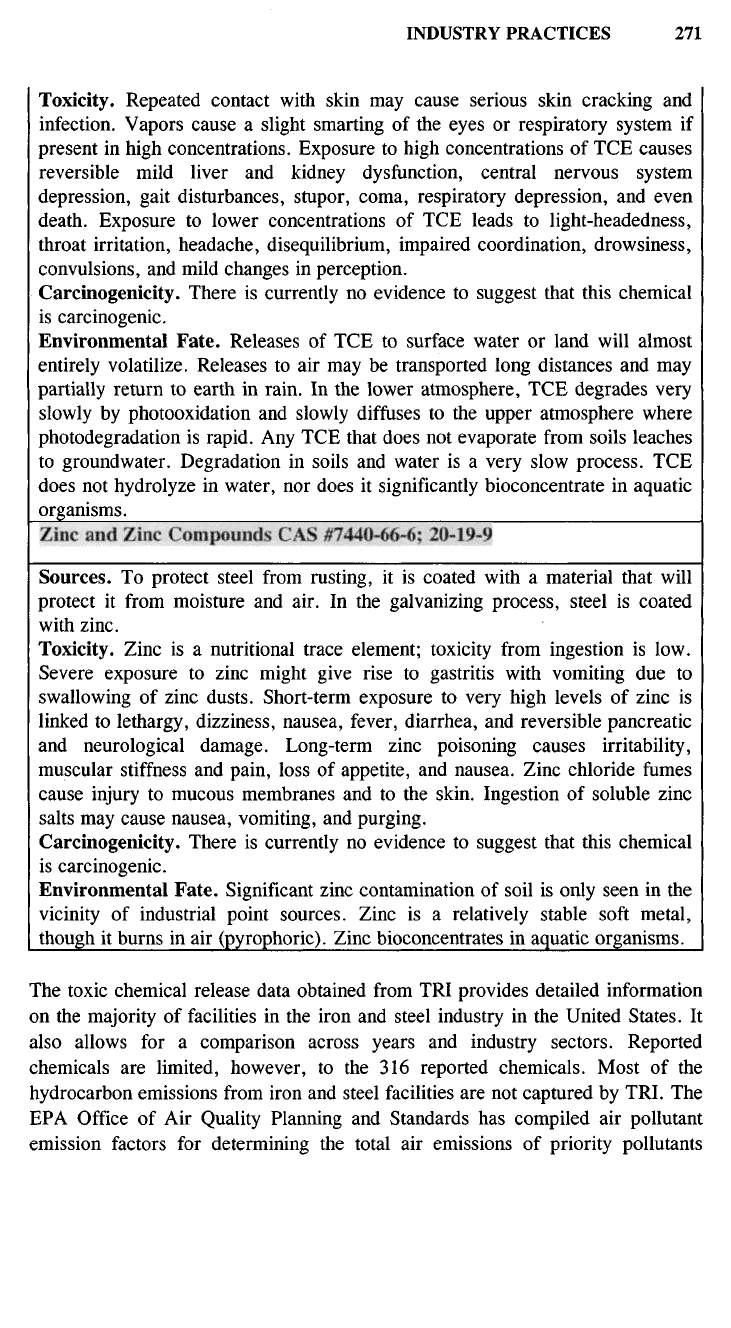
Toxicity. Repeated contact with skin may cause serious skin cracking and
infection. Vapors cause a slight smarting of the eyes or respiratory system if
present in high concentrations. Exposure to high concentrations of TCE causes
reversible mild liver and kidney dysfunction, central nervous system
depression, gait disturbances, stupor, coma, respiratory depression, and even
death. Exposure to lower concentrations of TCE leads to light-headedness,
throat irritation, headache, disequilibrium, impaired coordination, drowsiness,
convulsions, and mild changes in perception.
Carcinogenicity. There is currently no evidence to suggest that this chemical
is carcinogenic.
Environmental Fate. Releases of TCE to surface water or land will almost
entirely volatilize. Releases to air may be transported long distances and may
partially return to earth in rain. In the lower atmosphere, TCE degrades very
slowly by photooxidation and slowly diffuses to the upper atmosphere where
photodegradation is rapid. Any TCE that does not evaporate from soils leaches
to groundwater. Degradation in soils and water is a very slow process. TCE
does not hydrolyze in water, nor does it significantly bioconcentrate in aquatic
organisms.
Zinc and Zinc Compounds CAS #7440-66-6; 20-19-9
Sources. To protect steel from rusting, it is coated with a material that will
protect it from moisture and air. In the galvanizing process, steel is coated
with zinc.
Toxicity. Zinc is a nutritional trace element; toxicity from ingestion is low.
Severe exposure to zinc might give rise to gastritis with vomiting due to
swallowing of zinc dusts. Short-term exposure to very high levels of zinc is
linked to lethargy, dizziness, nausea, fever, diarrhea, and reversible pancreatic
and neurological damage. Long-term zinc poisoning causes irritability,
muscular stiffness and pain, loss of appetite, and nausea. Zinc chloride fumes
cause injury to mucous membranes and to the skin. Ingestion of soluble zinc
salts may cause nausea, vomiting, and purging.
Carcinogenicity. There is currently no evidence to suggest that this chemical
is carcinogenic.
Environmental Fate. Significant zinc contamination of soil is only seen in the
vicinity of industrial point sources. Zinc is a relatively stable soft metal,
though it burns in air (pyrophoric). Zinc bioconcentrates in aquatic organisms.
The toxic chemical release data obtained from TRI provides detailed information
on the majority of facilities in the iron and steel industry in the United States. It
also allows for a comparison across years and industry sectors. Reported
chemicals are limited, however, to the 316 reported chemicals. Most of the
hydrocarbon emissions from iron and steel facilities are not captured by TRI. The
EPA Office of Air Quality Planning and Standards has compiled air pollutant
emission factors for determining the total air emissions of priority pollutants
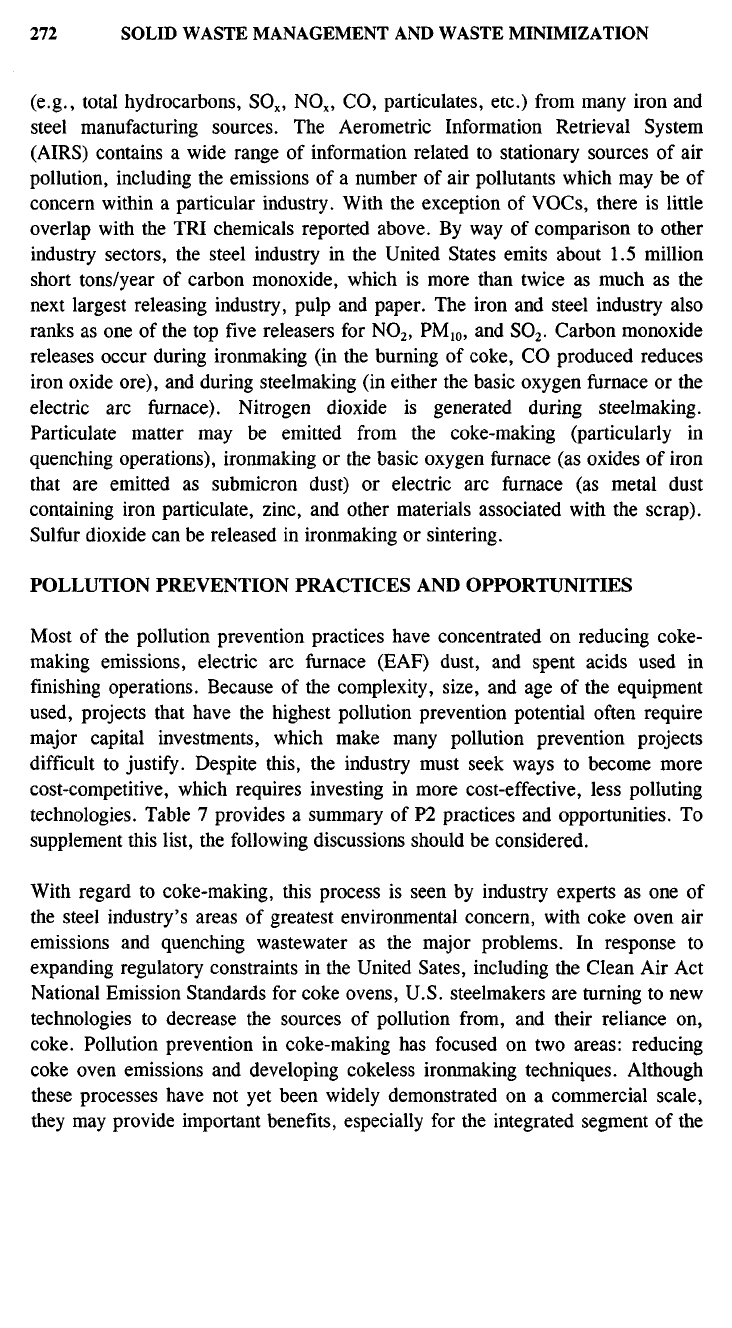
(e.g., total hydrocarbons, SO
x
, NO
x
, CO, participates, etc.) from many iron and
steel manufacturing sources. The Aerometric Information Retrieval System
(AIRS) contains a wide range of information related to stationary sources of air
pollution, including the emissions of a number of air pollutants which may be of
concern within a particular industry. With the exception of VOCs, there is little
overlap with the TRI chemicals reported above. By way of comparison to other
industry sectors, the steel industry in the United States emits about 1.5 million
short tons/year of carbon monoxide, which is more than twice as much as the
next largest releasing industry, pulp and paper. The iron and steel industry also
ranks as one of the top five releasers for NO
2
, PM
10
, and SO
2
. Carbon monoxide
releases occur during ironmaking (in the burning of coke, CO produced reduces
iron oxide ore), and during steelmaking (in either the basic oxygen furnace or the
electric arc furnace). Nitrogen dioxide is generated during steelmaking.
Particulate matter may be emitted from the coke-making (particularly in
quenching operations), ironmaking or the basic oxygen furnace (as oxides of iron
that are emitted as submicron dust) or electric arc furnace (as metal dust
containing iron particulate, zinc, and other materials associated with the scrap).
Sulfur dioxide can be released in ironmaking or sintering.
POLLUTION PREVENTION PRACTICES AND OPPORTUNITIES
Most of the pollution prevention practices have concentrated on reducing coke-
making emissions, electric arc furnace (EAF) dust, and spent acids used in
finishing operations. Because of the complexity, size, and age of the equipment
used, projects that have the highest pollution prevention potential often require
major capital investments, which make many pollution prevention projects
difficult to justify. Despite this, the industry must seek ways to become more
cost-competitive, which requires investing in more cost-effective, less polluting
technologies. Table 7 provides a summary of P2 practices and opportunities. To
supplement this list, the following discussions should be considered.
With regard to coke-making, this process is seen by industry experts as one of
the steel industry's areas of greatest environmental concern, with coke oven air
emissions and quenching wastewater as the major problems. In response to
expanding regulatory constraints in the United Sates, including the Clean Air Act
National Emission Standards for coke ovens, U.S. steelmakers are turning to new
technologies to decrease the sources of pollution from, and their reliance on,
coke.
Pollution prevention in coke-making has focused on two areas: reducing
coke oven emissions and developing cokeless ironmaking techniques. Although
these processes have not yet been widely demonstrated on a commercial scale,
they may provide important benefits, especially for the integrated segment of the
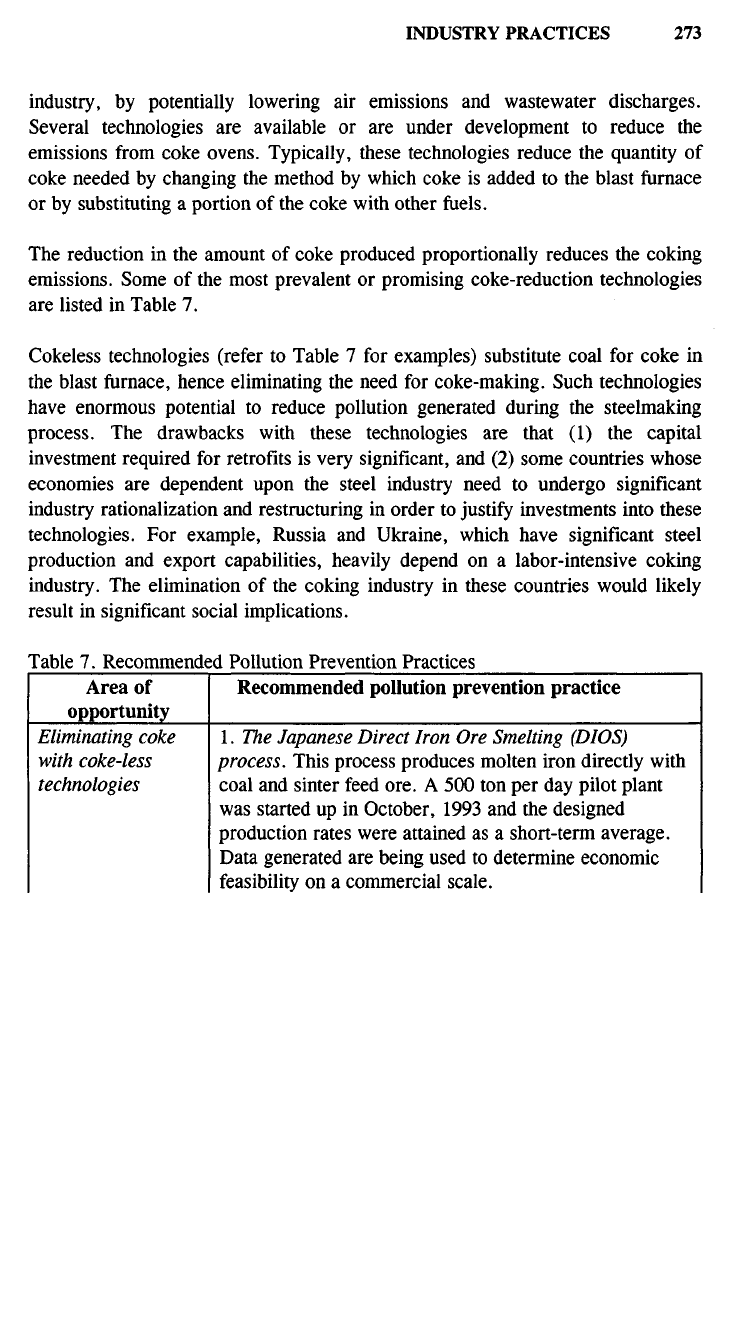
industry, by potentially lowering air emissions and waste water discharges.
Several technologies are available or are under development to reduce the
emissions from coke ovens. Typically, these technologies reduce the quantity of
coke needed by changing the method by which coke is added to the blast furnace
or by substituting a portion of the coke with other fuels.
The reduction in the amount of coke produced proportionally reduces the coking
emissions. Some of the most prevalent or promising coke-reduction technologies
are listed in Table 7.
Cokeless technologies (refer to Table 7 for examples) substitute coal for coke in
the blast furnace, hence eliminating the need for coke-making. Such technologies
have enormous potential to reduce pollution generated during the steelmaking
process. The drawbacks with these technologies are that (1) the capital
investment required for retrofits is very significant, and (2) some countries whose
economies are dependent upon the steel industry need to undergo significant
industry rationalization and restructuring in order to justify investments into these
technologies. For example, Russia and Ukraine, which have significant steel
production and export capabilities, heavily depend on a labor-intensive coking
industry. The elimination of the coking industry in these countries would likely
result in significant social implications.
Table 7. Recommended Pollution Prevention Practices
Area of
opportunity
Eliminating coke
with coke-less
technologies
Recommended pollution prevention practice
1.
The Japanese Direct Iron Ore Smelting (DIOS)
process. This process produces molten iron directly with
coal and sinter feed ore. A 500 ton per day pilot plant
was started up in October, 1993 and the designed
production rates were attained as a short-term average.
Data generated are being used to determine economic
feasibility on a commercial scale.
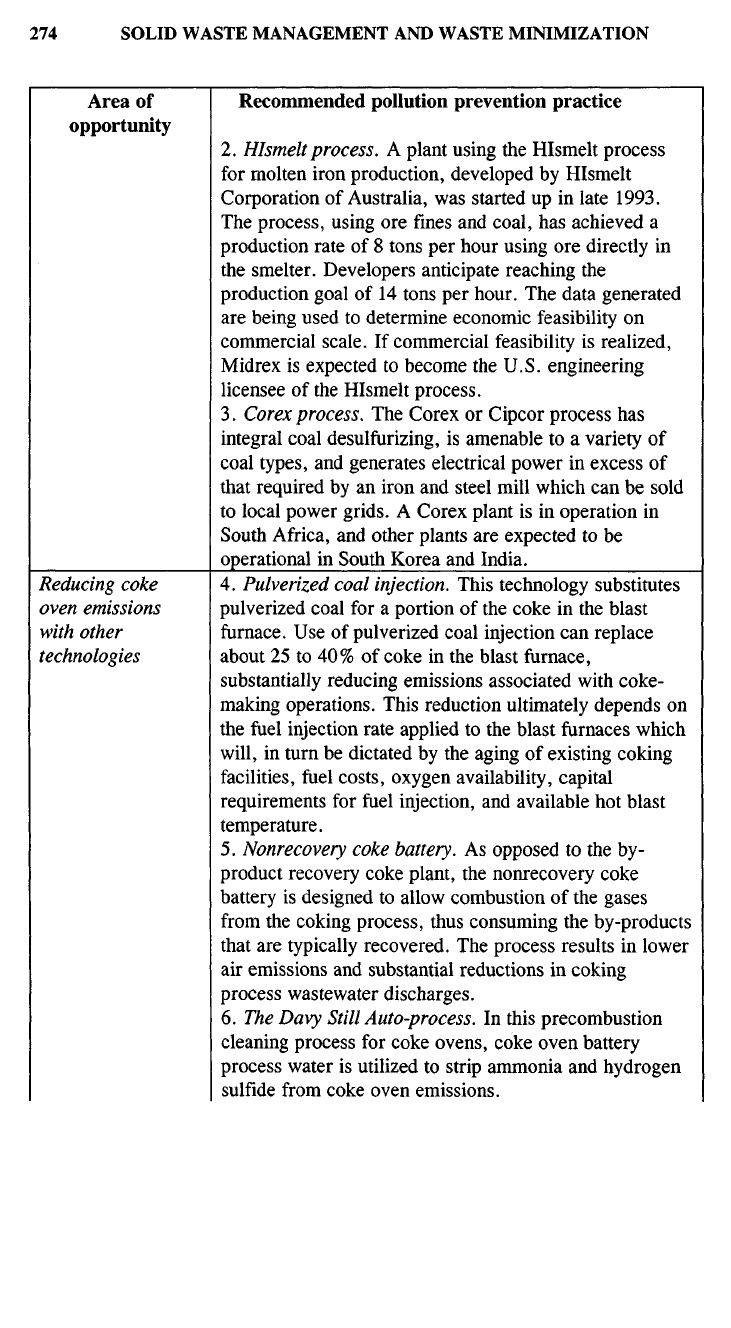
Area of
opportunity
Reducing coke
oven emissions
with other
technologies
Recommended pollution prevention practice
2.
HIsmelt process. A plant using the HIsmelt process
for molten iron production, developed by HIsmelt
Corporation of Australia, was started up in late 1993.
The process, using ore fines and coal, has achieved a
production rate of 8 tons per hour using ore directly in
the smelter. Developers anticipate reaching the
production goal of 14 tons per hour. The data generated
are being used to determine economic feasibility on
commercial scale. If commercial feasibility is realized,
Midrex is expected to become the U.S. engineering
licensee of the HIsmelt process.
3.
Corex process. The Corex or Cipcor process has
integral coal desulfurizing, is amenable to a variety of
coal types, and generates electrical power in excess of
that required by an iron and steel mill which can be sold
to local power grids. A Corex plant is in operation in
South Africa, and other plants are expected to be
operational in South Korea and India.
4.
Pulverized coal injection. This technology substitutes
pulverized coal for a portion of the coke in the blast
furnace. Use of pulverized coal injection can replace
about 25 to 40% of coke in the blast furnace,
substantially reducing emissions associated with coke-
making operations. This reduction ultimately depends on
the fuel injection rate applied to the blast furnaces which
will, in turn be dictated by the aging of existing coking
facilities, fuel costs, oxygen availability, capital
requirements for fuel injection, and available hot blast
temperature.
5.
Nonrecovery coke battery. As opposed to the by-
product recovery coke plant, the nonrecovery coke
battery is designed to allow combustion of the gases
from the coking process, thus consuming the by-products
that are typically recovered. The process results in lower
air emissions and substantial reductions in coking
process wastewater discharges.
6. The Davy Still Auto-process. In this precombustion
cleaning process for coke ovens, coke oven battery
process water is utilized to strip ammonia and hydrogen
sulfide from coke oven emissions.
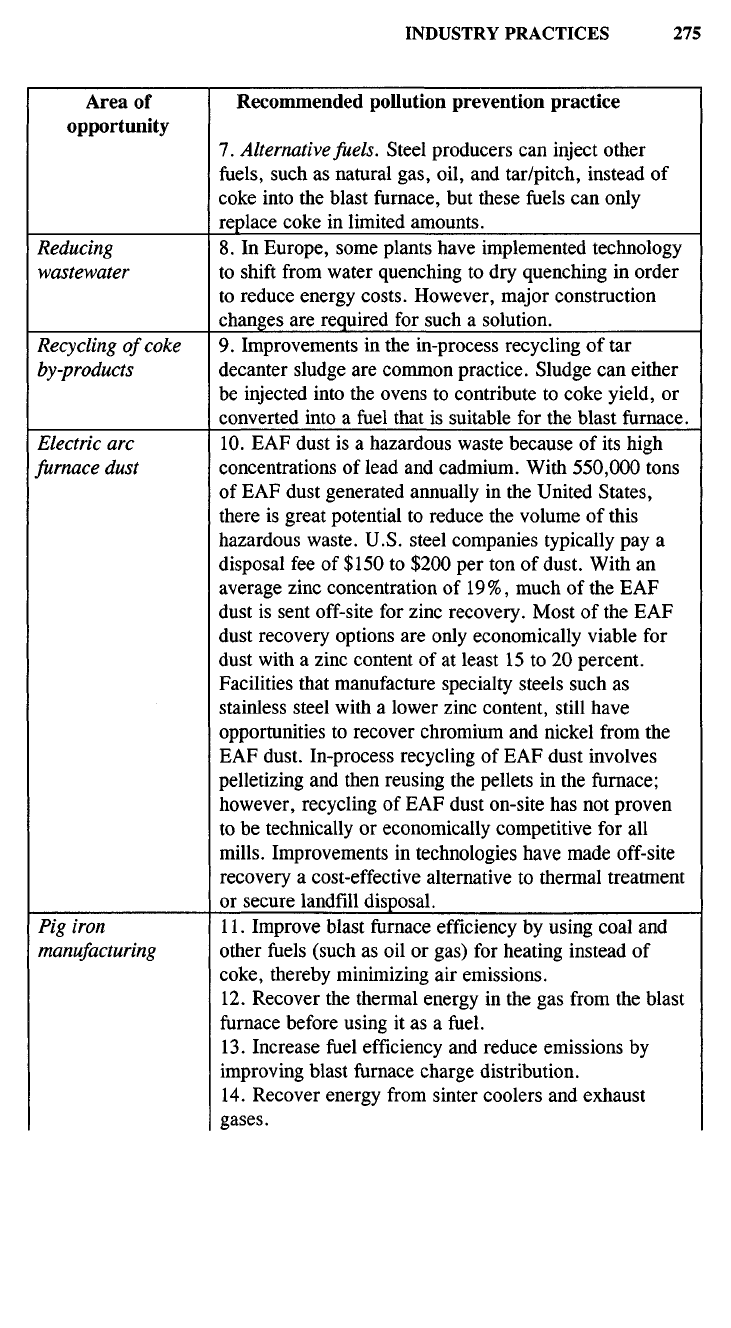
Area of
opportunity
Reducing
wastewater
Reveling of coke
by-products
Electric arc
furnace dust
Pig iron
manufacturing
Recommended pollution prevention practice
7.
Alternative fuels. Steel producers can inject other
fuels,
such as natural gas, oil, and tar/pitch, instead of
coke into the blast furnace, but these fuels can only
replace coke in limited amounts.
8. In Europe, some plants have implemented technology
to shift from water quenching to dry quenching in order
to reduce energy costs. However, major construction
changes are required for such a solution.
9. Improvements in the in-process recycling of tar
decanter sludge are common practice. Sludge can either
be injected into the ovens to contribute to coke yield, or
converted into a fuel that is suitable for the blast furnace.
10.
EAF dust is a hazardous waste because of its high
concentrations of lead and cadmium. With 550,000 tons
of EAF dust generated annually in the United States,
there is great potential to reduce the volume of this
hazardous waste. U.S. steel companies typically pay a
disposal fee of $150 to $200 per ton of dust. With an
average zinc concentration of 19%, much of the EAF
dust is sent off-site for zinc recovery. Most of the EAF
dust recovery options are only economically viable for
dust with a zinc content of at least 15 to 20 percent.
Facilities that manufacture specialty steels such as
stainless steel with a lower zinc content, still have
opportunities to recover chromium and nickel from the
EAF dust. In-process recycling of EAF dust involves
pelletizing and then reusing the pellets in the furnace;
however, recycling of EAF dust on-site has not proven
to be technically or economically competitive for all
mills.
Improvements in technologies have made off-site
recovery a cost-effective alternative to thermal treatment
or secure landfill disposal.
11.
Improve blast furnace efficiency by using coal and
other fuels (such as oil or gas) for heating instead of
coke,
thereby minimizing air emissions.
12.
Recover the thermal energy in the gas from the blast
furnace before using it as a fuel.
13.
Increase fuel efficiency and reduce emissions by
improving blast furnace charge distribution.
14.
Recover energy from sinter coolers and exhaust
gases.
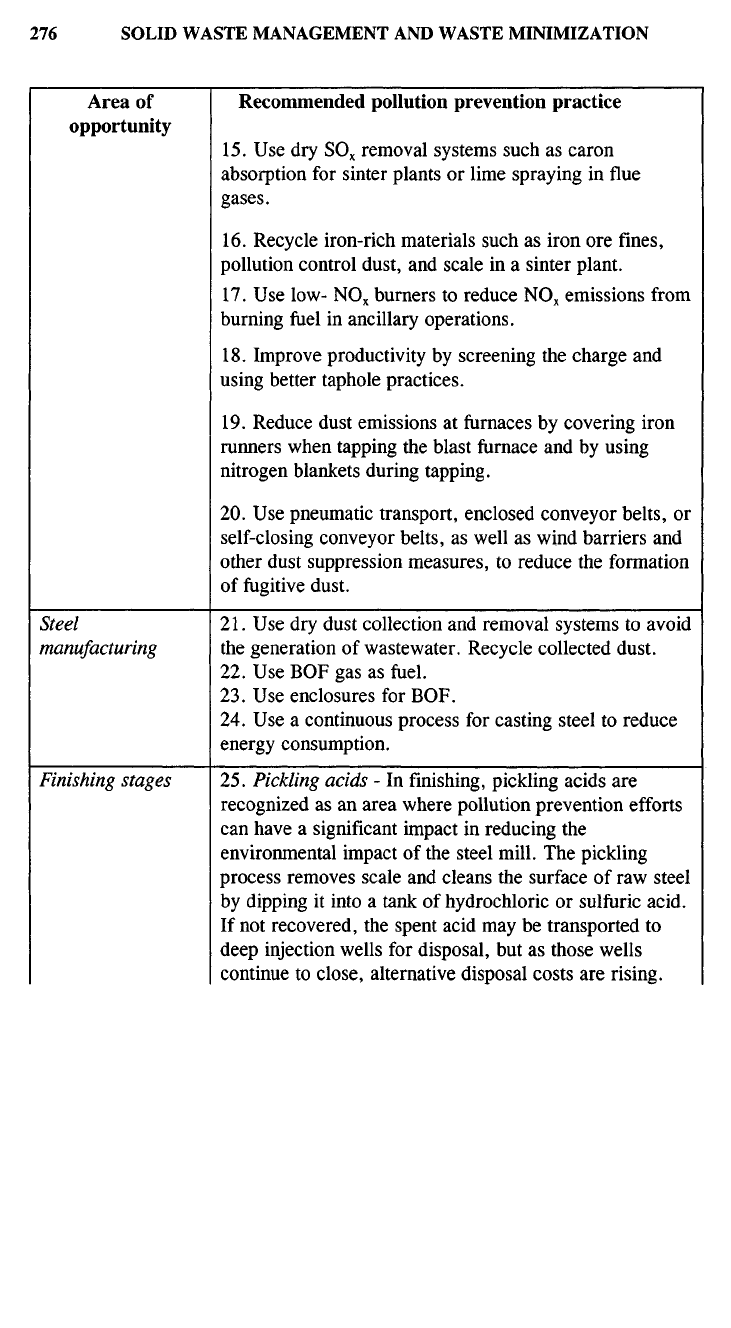
Area of
opportunity
Steel
manufacturing
Finishing stages
Recommended pollution prevention practice
15.
Use dry SO
x
removal systems such as caron
absorption for sinter plants or lime spraying in flue
gases.
16.
Recycle iron-rich materials such as iron ore fines,
pollution control dust, and scale in a sinter plant.
17.
Use low- NO
x
burners to reduce NO
x
emissions from
burning fuel in ancillary operations.
18.
Improve productivity by screening the charge and
using better taphole practices.
19.
Reduce dust emissions at furnaces by covering iron
runners when tapping the blast furnace and by using
nitrogen blankets during tapping.
20.
Use pneumatic transport, enclosed conveyor belts, or
self-closing conveyor belts, as well as wind barriers and
other dust suppression measures, to reduce the formation
of fugitive dust.
21.
Use dry dust collection and removal systems to avoid
the generation of wastewater. Recycle collected dust.
22.
Use BOF gas as fuel.
23.
Use enclosures for BOF.
24.
Use a continuous process for casting steel to reduce
energy consumption.
25.
Pickling acids - In finishing, pickling acids are
recognized as an area where pollution prevention efforts
can have a significant impact in reducing the
environmental impact of the steel mill. The pickling
process removes scale and cleans the surface of raw steel
by dipping it into a tank of hydrochloric or sulfuric acid.
If not recovered, the spent acid may be transported to
deep injection wells for disposal, but as those wells
continue to close, alternative disposal costs are rising.
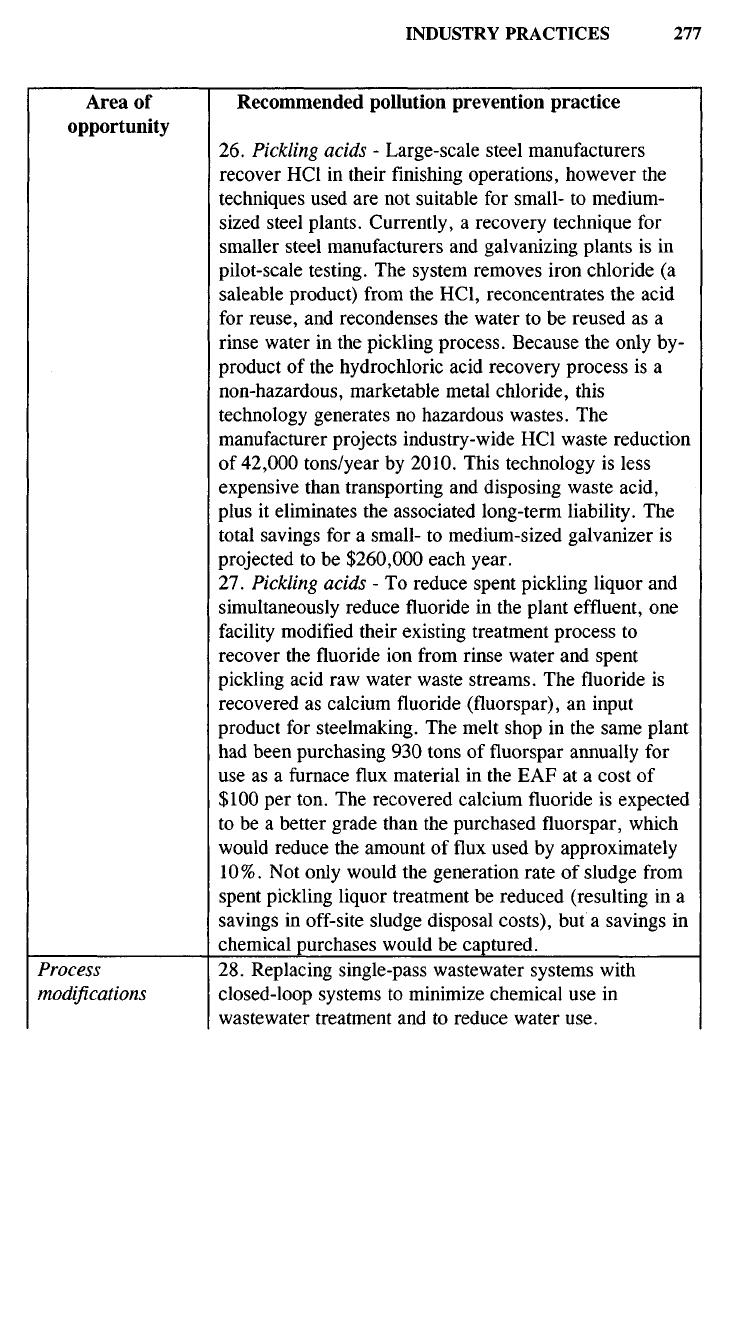
Area of
opportunity
Process
modifications
Recommended pollution prevention practice
26.
Pickling acids - Large-scale steel manufacturers
recover HCl in their finishing operations, however the
techniques used are not suitable for small- to medium-
sized steel plants. Currently, a recovery technique for
smaller steel manufacturers and galvanizing plants is in
pilot-scale testing. The system removes iron chloride (a
saleable product) from the HCl, reconcentrates the acid
for reuse, and recondenses the water to be reused as a
rinse water in the pickling process. Because the only by-
product of the hydrochloric acid recovery process is a
non-hazardous, marketable metal chloride, this
technology generates no hazardous wastes. The
manufacturer projects industry-wide HCl waste reduction
of 42,000 tons/year by 2010. This technology is less
expensive than transporting and disposing waste acid,
plus it eliminates the associated long-term liability. The
total savings for a small- to medium-sized galvanizer is
projected to be $260,000 each year.
27.
Pickling acids - To reduce spent pickling liquor and
simultaneously reduce fluoride in the plant effluent, one
facility modified their existing treatment process to
recover the fluoride ion from rinse water and spent
pickling acid raw water waste streams. The fluoride is
recovered as calcium fluoride (fluorspar), an input
product for steelmaking. The melt shop in the same plant
had been purchasing 930 tons of fluorspar annually for
use as a furnace flux material in the EAF at a cost of
$100 per ton. The recovered calcium fluoride is expected
to be a better grade than the purchased fluorspar, which
would reduce the amount of flux used by approximately
10%.
Not only would the generation rate of sludge from
spent pickling liquor treatment be reduced (resulting in a
savings in off-site sludge disposal costs), but a savings in
chemical purchases would be captured.
28.
Replacing single-pass waste water systems with
closed-loop systems to minimize chemical use in
waste water treatment and to reduce water use.
